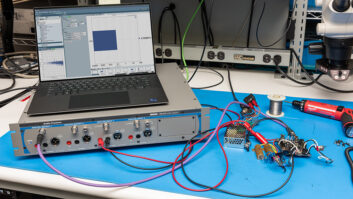Split-Monitoring Analog Recording Console
As more console makers concentrate their product development efforts toward compact digital designs, it is somewhat surprising to find a new company specifically targeting the market for large analog boards. However, the first product from Tri-Tech Audio – a new British company formed by a group of ex-Trident employees – is a “traditional” large-format analog recording console.
Tri-Tech’s new TS-24, which is available in 32-, 40-, 48- and 56-input versions, looks similar to Trident’s 1980-vintage Series 80, but offers more features and better performance specs. Like the Series 80, the 24-bus TS-24 uses a split-monitor approach. This creates a larger console surface than an in-line design (up to nearly 3.5-meters wider), but offers a relatively simple layout. And since the TS-24’s console topology is based around the Series 80, former Trident users should feel right at home.
The TS-24 is straightforward with no surprises, just a combination of quality components and a no-nonsense circuit design. The list of parts’ suppliers include such leading companies as Mosses and Mitchell (TT patchbays), Sellmark, Penny & Giles (conductive plastic faders) and Kingshill (PSU). Throughout the board, all inputs and outputs, except studio playback, are electronically balanced; transformer-coupled mic preamps are optional.
Input channels offer a choice for one mic and two line inputs. The mic amplifier provides up to 60 dB of gain and there are 20dB pad, phase and phantom power switches. All equalization controls offer a ñ15dB boost/cut range, and the 4-band EQ section has two semi-parametric mid-band controls (Q can be switched between narrow and broad slopes), shelving LF and HF bands, and variable high- and lowpass filters. A switchable 60Hz bass roll-off is also provided, as is an overall EQ bypass switch.
Each input channel offers a total of 12 aux sends, though only eight can be used simultaneously. Auxes 1/2 are mono, pre-fader; auxes 3/4 are mono with a pre/post fader select switch; and auxes 5/6 and 7/8 are also pre/post fader selectable, but can also be set to operate as stereo pairs, routed by the ST 9/10 and ST 11/12 switches. All aux sends feature individual cut switches.
Channel assignments to the 24-output buses are via 12 paired switches and the panpot; 24 individual bus assign switches are optional. There is also an alternative recording bus send scheme using the 3/4 aux send controls.
Each 2-channel monitor module provides comprehensive controls for monitoring either the group output bus or a choice of two tape returns. Three-band EQ is activated by a switch with an associated LED and includes HF and LF shelving at 10k and 100 Hz, plus sweepable mid-band EQ. Full-length conductive plastic faders normally control the group output level, but these may be swapped with the monitor level control, allowing fader control of monitor levels. An RMX switch assigns the monitor signal to the main stereo mix bus.
As on the input channel, there are 12 aux sends, ten of which may be used at one time. Aux sends 1/2 and 3/4 are prefade; aux sends 5/6, 7/8 are selectable pre/post fade and all feature individual cut switches. Aux sends 9/10 are configured as a stereo pair, pre/post selectable, with cut and pan facilities and can also be switched to aux sends 11/12.
The central facilities section contains monitor and aux bus master level controls, oscillator and talkback sections and four-stereo effects return channels. Each effects return channel has a 2-band EQ (HF/LF shelving) and can be routed to the main stereo bus or auxes 11/12. Two Auto Mute master switches provide control of any selected combination of input or tape monitor channel, and two switches marked User 1 and User 2 may be configured as the operator wishes.
Also within the master section is the control room listening source selector, which switches among the aux master sends, four-stereo sources, RMX (tape returns master) or the studio cue mix. There is also switching for two pairs of reference speakers. Metering is comprehensive and includes 12 bar graphs for aux send levels; two main bus VU meters (PPM optional); two LED bar graphs on the AFL source; and 24 VU meters (PPM optional) display group/tape levels.
Tri-Tech Audio will debut the TS-24 analog console in the U.S. at this month’s AES show in Los Angeles. Prices begin at $48,000. The company also plans to market rackmount modules based on Trident mic preamps and EQs, and will offer technical service and support plus reconditioned spare parts for other Trident consoles, such as the TSM, Series 80, Series 65, Vector and Series 90.







